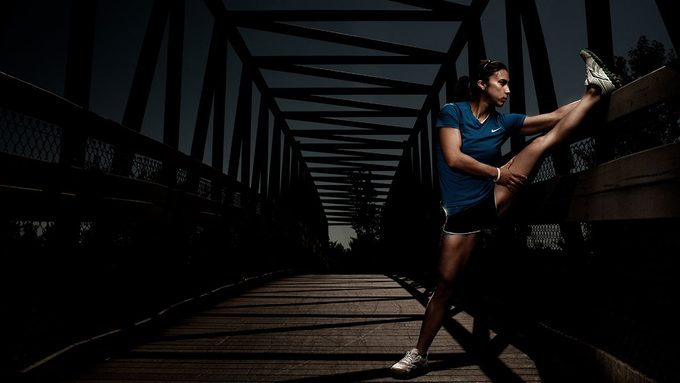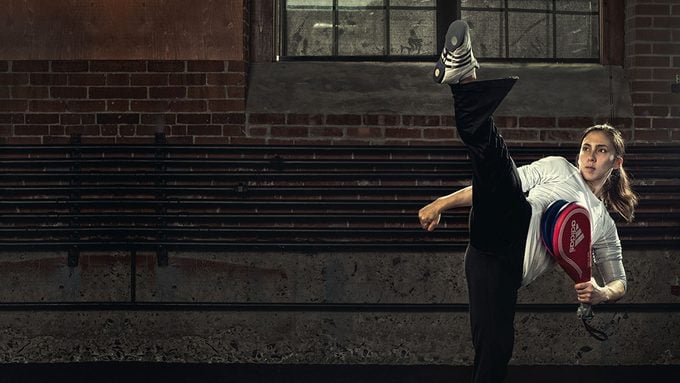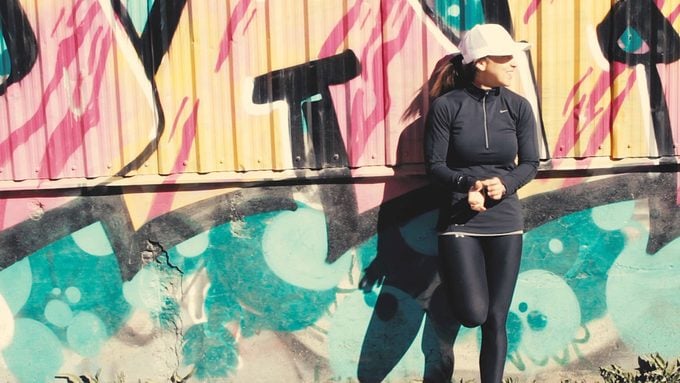Power Of Fitness: “I Have AS Disease, And The Pain Doesn’t Stop Me From Being Active.”
A debilitating disease wasn’t an option for Naomi Ban. She couldn’t change her diagnosis, but she did stay active. Here’s how.

As a lover of fitness, sports and anything active, Naomi Ban, a strength coach and kinesiologist at McGill University, specializing autoimmune and inflammatory disorders, was devastated when she was diagnosed with Ankylosing Spondylitis (AS). It’s a systemic disease, typically affecting men more than women, is a stiffness in the back and hips, but as a rheumatic condition it can affect the entire body. It can also cause fatigue and pain. “I felt a heavy weight of despair on my shoulders,” she says. Her rheumatologist told her she couldn’t play contact sports, including martial arts or weight train with heavy weights. “That would accelerate the degeneration of my spine, which could cripple me in the future.” But she now has full control over the AS effects on her body, and went from training clients to become “bikini ready” to helping others living with chronic pain, too. Here is how she discovered her #BHmoment, by working through the pain and living with AS.
Why did you make the career change?
“I felt lucky to work in a field that I was so passionate about, but there was a part inside of me that wasn’t fulfilled, and felt I could contribute more. When I was diagnosed with AS, and couldn’t find any information out there on athletics and training, concerning my disorder, I was devastated because I’ve always been a competitive athlete. Movement has been a focal point of who I was since a very young age. I even studied kinesiology— the study of movement.” She is also an unpaid patient advocate supporting disease awareness activities with AbbVie, a biopharmaceutical company that makes prescription medication for autoimmune treatments. (For info, check out standuptobackpain.ca)
“So, I decided to do some research – something I love. There are more than 100 different kinds of arthritic disorders and many rare diseases that no one has even heard of,” she says. “I’m happy to say that I’ve rattled the rheumatology world, because I’ve taken a new approach to exercise for these diseases, which does not coincide with the suggested exercise protocol currently given. I’m training clients with diverse disorders and they are getting amazing results.”
What was your #BHmoment?
“My goal was to make a difference in the medical world, to bring forth a change and new theories. Without my own disorder, I probably would not have realized the lack of resources there is about training with diseases and orient my career in this direction. I currently have full control over my disorder and am redirecting my career towards helping others with chronic pain achieve the same outcome.”
How does living with AS help you treating clients with similar disorders?
“I learned that it’s normal to feel overwhelmed and alone during the diagnosis phase of a disease. I always give the example of the seven phases of grief whenever I talk about my experience. Most people get stuck at the denial or anger phase for a while, but if they want to achieve closure and move forward, they need to go through the last phase which is “acceptance.” I accept I have this disorder and I will do everything in my power to make my body stronger and resilient. I hold the key to my success and my failures.”

What would you have done differently?
“Definitely not shut myself from the world. I went from being a competitive athlete – a taekwondo competitor and a beast in the weight room – to a weak person that needed the aid of a cane to walk around. Getting out of my car was a 10-minute task and I felt a loss of identity. I stayed in the anger phase for a long time and pushed away family and friends. I think today I would have put my ego aside and accept assistance/help from people who care and love me.”
What would you want others to know about your journey?
“Nobody can do it for you. You can have all the right tools in the world, but if you don’t have the courage to take those tools out and start building something with them, you won’t have anything to show. Yes, it’s about slowing down the progression of a disease, but most importantly it’s about achieving a better quality of life. This quality of life with allow them to exercise daily, eat healthier and that will in turn will slow down the disease progression.”
How is your life now living with AS?
“More fulfilling.”
What is the biggest tip you tell friends?
“To believe in yourself and trust that voice inside your head. Achieving empowerment is like climbing and reaching the top of a mountain. Believing you can achieve something and then realizing you actually did it is one of the most empowering moments in someone’s life. It opens the door to new ventures and endless dreams.”
You are awesome Naomi. Please keep changing the world.





